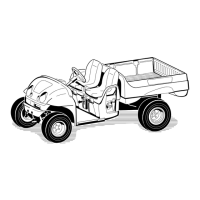• A v oid dri ving when it is dark, especially in
unfamiliar areas . If y ou m ust dri v e when it
is dark, be sure to dri v e cautiously , use the
headlights , and ev en consider adding additional
lights .
• Be extremely careful when operating around
people . Alw a ys be a w are of where b ystanders
might be .
• Before operating the v ehicle , alw a ys c hec k the
designated areas of the v ehicle that are stated
in the pre-star ting section of this man ual. If
something is wrong, do not use the v ehicle .
Mak e sure that the problem is cor rected before
the v ehicle or attac hment is operated.
• Since g asoline is highly flammable , handle it
carefully .
– Use an appro v ed g asoline container .
– Do not remo v e the cap from the fuel tank
when the engine is hot or r unning .
– Do not smok e while handling g asoline .
– Fill the fuel tank outdoors , and fill it to
about 1 inc h (25 mm) belo w the top of the
tank (the bottom of the filler nec k). Do
not o v erfill it.
– Wipe up any spilled g asoline .
Operation
Engine exhaust contains carbon mono xide,
which is an odor less, deadl y poison that can
kill y ou.
Do not r un engine indoor s or in an enclosed
ar ea.
• T he operator and passeng er should remain
seated whenev er the v ehicle is in motion.
T he operator should k ee p both hands on the
steering wheel whenev er possible , and the
passeng er should use the hand holds pro vided.
K ee p y our ar ms and legs within the v ehicle
body at all times .
• Dri v e slo w er and tur n less shar ply when y ou
are car r ying a passeng er . R emember y our
passeng er ma y not be expecting y ou to brak e
or tur n and ma y not be ready .
• Alw a ys w atc h out for and a v oid lo w o v erhangs
suc h as tree limbs , door jambs , and o v er -head
w alkw a ys . Mak e sure there is enough room
o v er head to easily clear the v ehicle and y our
head.
• Alw a ys shift into neutral and apply the parking
brak e before lea ving an idling v ehicle , or else
the v ehicle ma y cree p .
• F ailure to operate the v ehicle safely ma y result
in an accident, tip o v er of the v ehicle , and
serious injur y or death. Dri v e carefully . T o
prev ent tipping or loss of control:
– Use extreme caution, reduce speed, and
maintain a safe distance around sand traps ,
ditc hes , creeks , ramps , unfamiliar areas ,
or any areas that ha v e abr upt c hang es in
g round conditions or elev ation.
– W atc h for holes or other hidden hazards .
– Use extra caution when operating the
v ehicle on w et surfaces , in adv erse w eather
conditions , at higher speeds , or with a
full load. Stopping time and distance will
increase with a full load.
– A v oid sudden stops and star ts . Do not
g o from rev erse to forw ard or forw ard to
rev erse without first coming to a complete
stop .
– Slo w do wn before tur ning . Do not attempt
shar p tur ns or abr upt maneuv ers or other
unsafe dri ving actions that ma y cause a loss
of v ehicle control.
– W hen dumping, do not let any one stand
behind the v ehicle and do not dump the
load on any one’ s feet. R elease the tailg ate
latc hes from the side of the bo x, not from
behind.
– Only operate the v ehicle when the carg o
bo x is do wn and latc hed.
– Before bac king up , look to the rear and
ensure that no one is behind y ou. Bac k up
slo wly .
– W atc h out for traffic when y ou are near or
crossing roads . Alw a ys yield the right of
w a y to pedestrians and other v ehicles . T his
v ehicle is not designed for use on streets or
highw a ys . Alw a ys signal y our tur ns or stop
early enough so that other people kno w
what y ou plan to do . Obey all traffic r ules
and regulations .
– T he electrical and exhaust systems of the
v ehicle can produce sparks capable of
5

